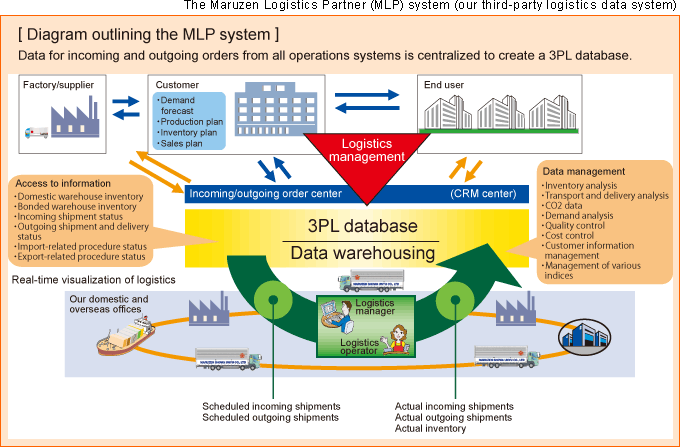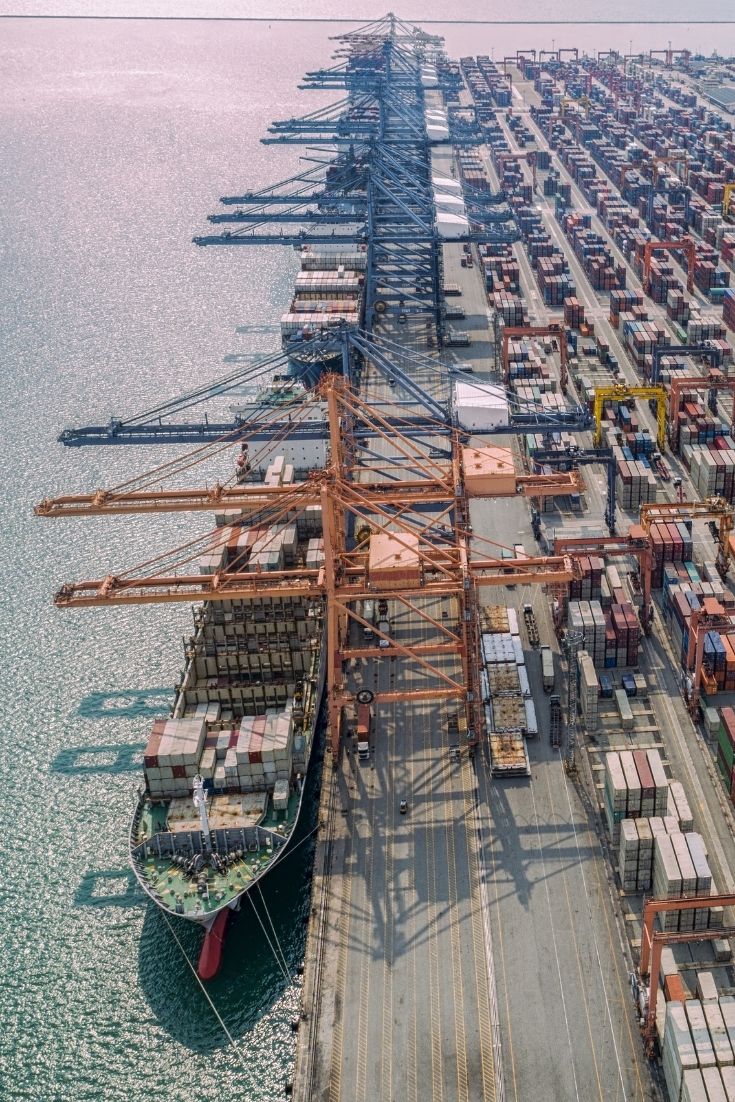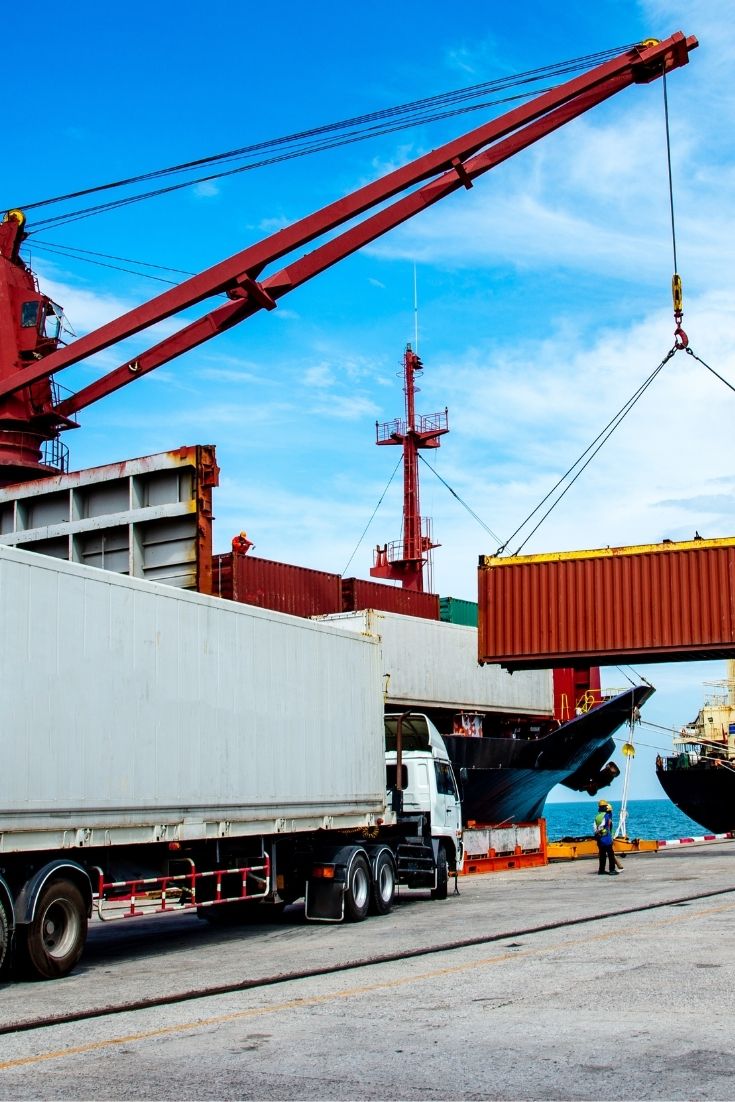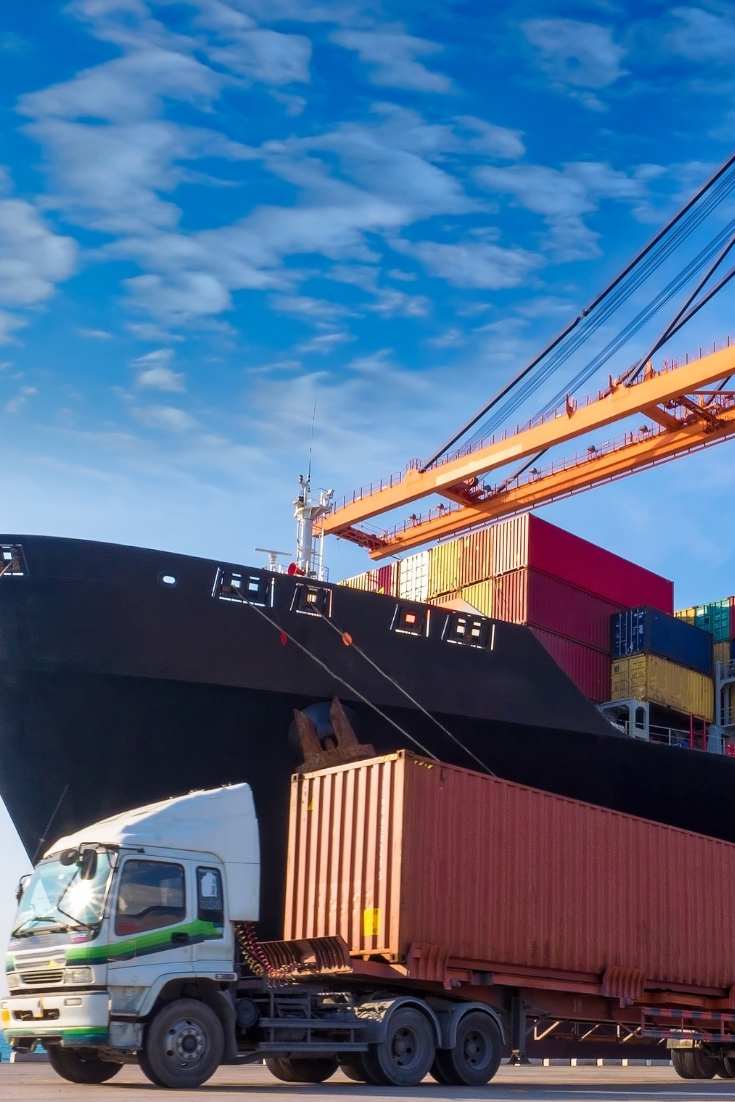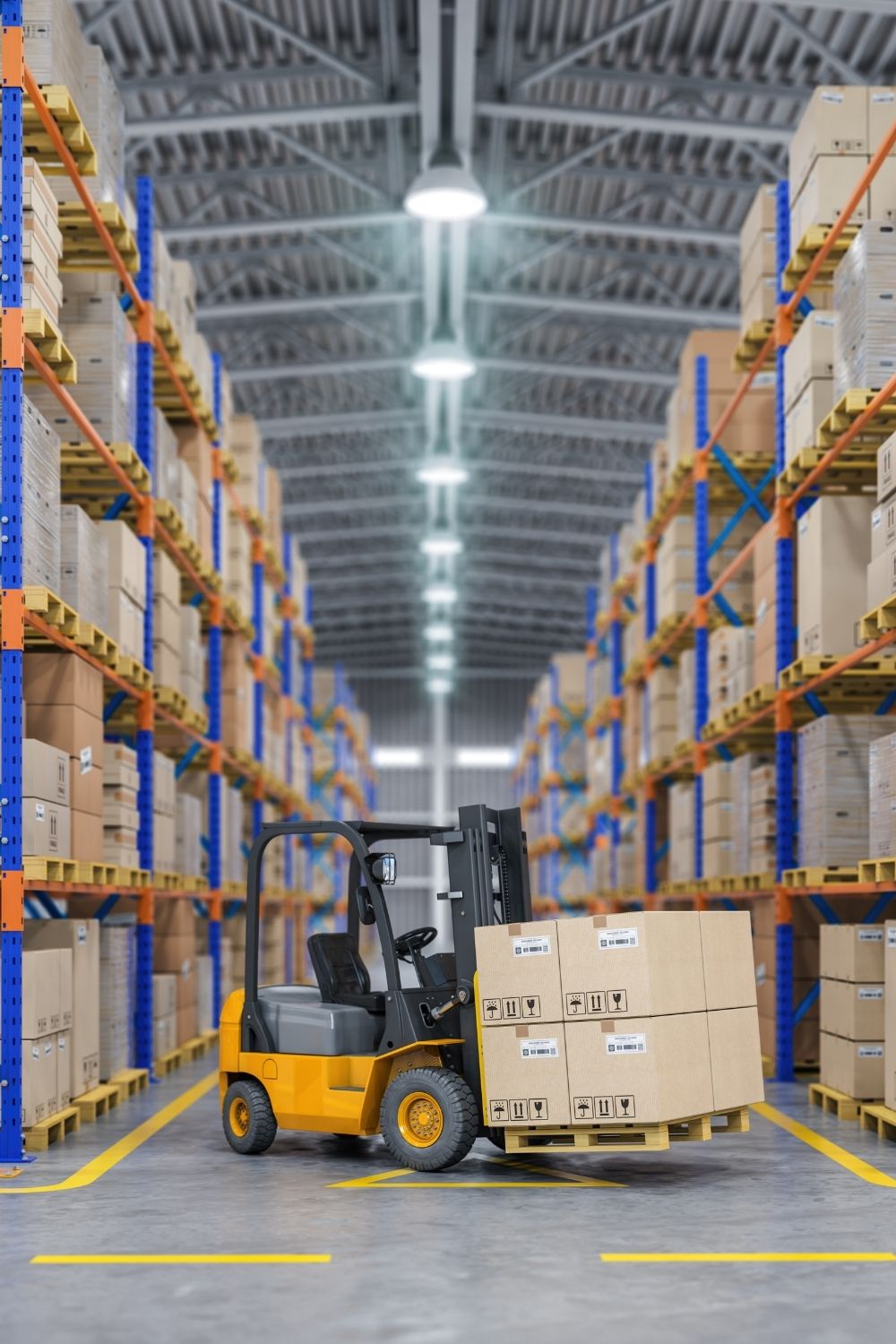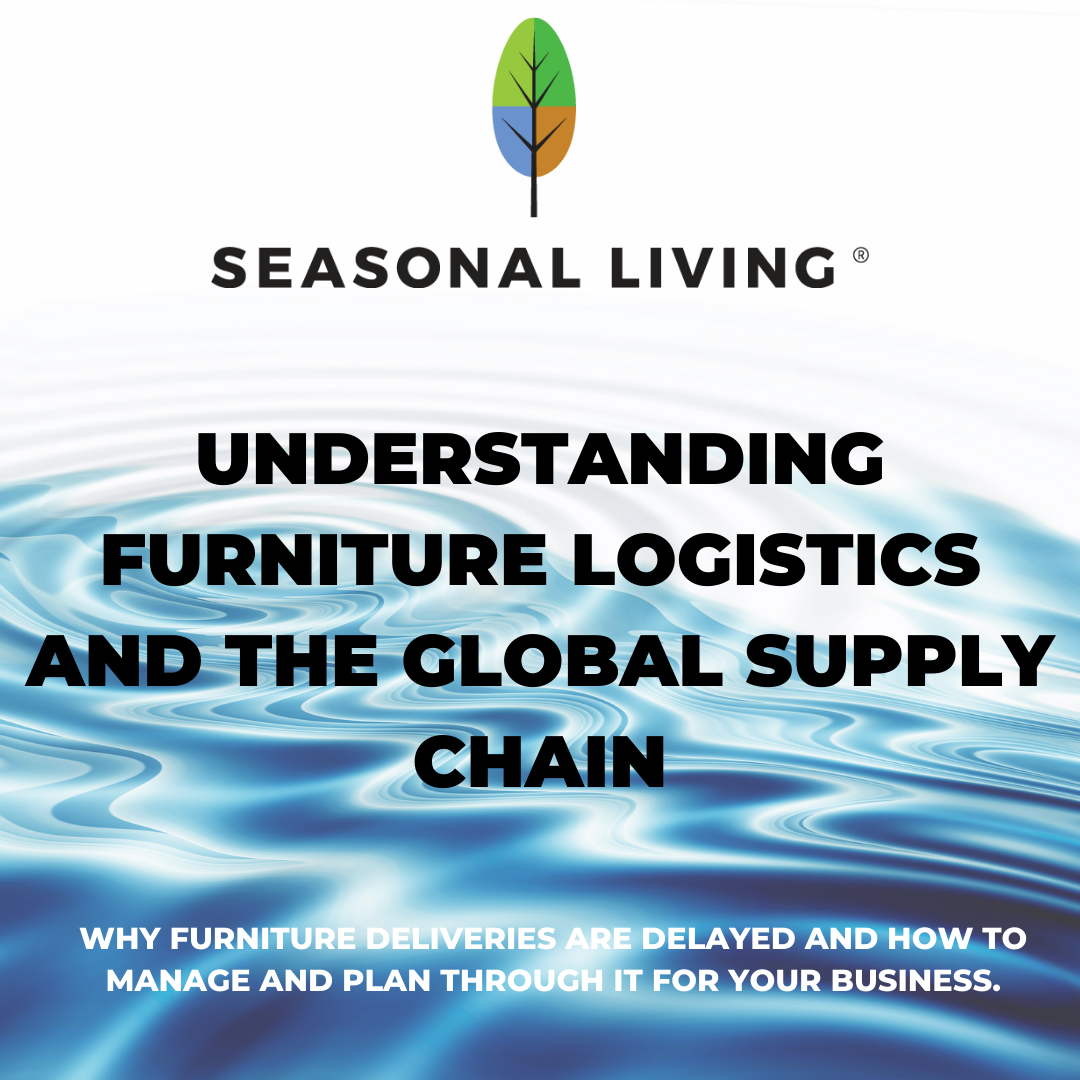
As many of you reading this are probably aware, the furniture industry is experiencing unprecedented disruptions to its global supply chain, causing delays in deliveries of furniture. This disruption is not just impacting the furniture industry, either. It is impacting every industry.
Seasonal Living, an importer of modern indoor/outdoor furniture, lighting and decorative accessories for the past 17 years – much of which is made by artisans in Vietnam, Indonesia, Thailand, Mexico, Italy and India – has not been as severely impacted as others, to this point.
Our pre-planning and strong *in stock* position on much of our inventory has insured our ability to ship the majority of our collections in a timely manner from our Dallas, TX warehouse as of this writing, but as 2021 goes forward, we are being impacted as are most of our fellow furniture manufacturers.
And even though our FIZZ indoor/outdoor upholstery is made here in the United States, (our Grand Royal curved indoor/outdoor sectional is shown below) our supplier imports some of the parts for it from Asia, (as do most other Made In The USA upholstery manufacturers), which means that even stateside * Made In The USA* manufacturing can be impacted by lack of imported components.
Given our intimate familiarity with the import/export business, we are taking the opportunity in this post to broadly inform you about some of the “ins and outs” of the global shipping and logistics industry, as well as the current freight situation, so you can better understand how to plan – whether you’re an interior designer, retailer, fellow manufacturer or an interested consumer/ homeowner reading this post.
This is a complex subject and our objective in this blog post is to provide you with a good overview, (it’s not possible in this article to cover every detail related to this complex matter). Most importers will have variations of the same subject as it pertains to their business. We hope this helps you to have a better understanding of the shipping & freight situation as it stands in Spring 2021.
First, you may be wondering, “Why Is So Much Furniture Made Overseas?”
Furniture factories in the US began to outsource furniture production starting about 20 years ago now. They then imported that production back into the USA for sale. They did this because, as overseas countries opened up their economies to capitalism, it allowed those countries to become extremely competitive on price, as their labor and operating costs are lower than those of USA based manufacturers.
As it’s a natural desire on the part of most consumers to want the best they can afford, for the lowest price, many American manufacturers were forced to turn to other countries for their production, in order to remain competitive on pricing and stay in business.
In Seasonal Living’s case, however, our founder and CEO, Gary Pettitt’s motivation to start an import/export company 17 years ago wasn’t just to be competitive on pricing.
Gary knew he wanted to support the artisanal traditions in the family owned companies he had seen on his worldwide travels. He knew that the craftsmanship inherent in these traditions, passed down through many generations, would die out eventually unless they found a market in the United States, so he founded Seasonal Living in order to support them.
Today, if Seasonal Living’s collections were manufactured in the United States, however, they would be more expensive due to the artisanal knowledge and craftsmanship required to produce them and the extremely high quality of the indoor/outdoor materials used in their production.
So, Seasonal Living (and most other furniture companies in the USA today) are importers at some level. Some are importers of finished products like Seasonal Living, some are importers of components from China and other countries that are used in their Made In The USA production process.
UNDERSTANDING GLOBAL LOGISTICS AND SHIPPING AND WHAT’S CAUSING THE SLOWDOWN IN DELIVERIES:
As you can see from the below diagram, logistics are complicated and require careful planning whether shipping into the US from overseas or within the USA itself.
Furniture manufacturers import furniture or parts of furniture on shipping containers, as seen in the image below. These containers are either 40 foot containers (& varying versions of) or 20 foot containers. There are a handful of steamship companies who control the majority of “freight” (containers) and vessels (ships) in the world.
When a furniture importer places their order with an overseas factory, the overseas factory notifies the furniture importer when their order is ready to be shipped. The furniture importer then contracts for the container and the space for their container on a shipping vessel (ship).
Normally, this distribution process is smooth and relatively easy, the ship sails and, within a few weeks, docks in a port in the USA.
So what happened? Why all the delays now?
First, the uncertainty regarding the USA government’s import tariff situation on goods manufactured in China meant many furniture manufacturers started moving their shipping and production from China to other countries starting in late 2018, and through 2019, in order to offset the increase in prices (as a result of the tariffs) they would need pass on to their customers.
This caused some disruptions not only in established manufacturing demand (labor, raw materials, packaging, etc.) but also in logistics and delivery times, even then, as other countries were not sufficiently scaled up to support the increased demand in manufacturing and shipping resources.
This increased manufacturing demand also meant that more vessels and containers had to ship more products from the countries in the Asia-Pacific region.
Then, on top of this, in early 2020, the COVID-19 pandemic struck.
Covid-19 meant [ and means ] that many workers are out sick or have had to quit their jobs to care for their children or elderly parents living with them.
Covid-19 means uncertainty.
It means that, from day to day, many overseas and USA factories, many shippers, many ports, most rail / air transportation companies, many trucking companies, many receiving warehouses and delivery services are challenged to plan for how many workers will be on hand that day to produce product, package and ship to your home.
The Covid-19 pandemic has created a historical event (unprecedented in the modern era) that is challenging many businesses around the globe.
If you are the buyer waiting for a delivery promised to you months ago, whether you are an interior designer, a retailer or the consumer depending on your designer/retailer for that delivery, it is extremely frustrating.
And we know you are wondering, “Why am I being told one thing about delivery one day, and then something else the next day?”
Let us explain further, so you will have a deeper understanding that this is *nobody’s fault* and that everyone is doing the best they can to manage through this crisis of uncertainty.
Below, a container getting offloaded from a ship at port. As you can see, it takes highly skilled machine operators to offload containers safely. Often these days, some of these machine operators are out sick and from one day to the next, companies don’t know if they will be able to bring their ships into port, or if the personnel will be available to offload the containers.
Once the containers are offloaded, they are loaded onto trucks at the port facility, where they will be taken to warehouses to be unloaded.
However, there is a record low number of available drivers due to Covid-19. The demand for drivers causes delays as containers wait for trucks at port. Containers are stacked at a container yard while they wait. The container yards are now so full, that many containers are “buried” under others, and importers have to wait until their containers are free for a driver to pick them up. Warehouses are also short-staffed, and do not have sufficient head count to offload, tag, and store the merchandise from a container in a timely manner.
Containers often look like this, inside.
Containers arriving to a receiving warehouse. As you can imagine, it takes time, and careful handling to offload the merchandise within these 40′ containers.
Once all merchandise is unloaded in a receiving warehouse, the warehouse logistics manager and his/her team tag, label and place the merchandise in racks, to prepare it for repacking to smaller delivery trucks destined for your home.
All of this takes well trained people to handle and manage and if the employees are sick, or have had to take extended leaves of absence or have had to quit, everything gets further delayed.
A logical question to ask might be, “Can’t you hire temporary workers?”
Depending on the state and city, and their restrictions on workplaces due to Covid, the answer is “sometimes”, but even then, there is a training period and because city and state restrictions change every day, all around the country, it is never a certainty as to whether or not temporary workers will be available, whether or not they will test negative for Covid-19 before you bring them into your workplace, and whether or not your city/state will allow them to stay, from day to day.
FREIGHT COSTS
Now that you have a better understanding of how the global supply chain works and how it depends on well trained people, working together from around the world, let’s discuss some of the factors impacting the increasing freight costs on furniture. With demand for furniture as high as it is in the USA (more of our customers are realizing that their homes are their primary assets as well as where they are spending their time), more and more are investing in their homes….all resulting in increased demand.
Without getting too technical, the bottom line comes down to 6 broad factors:
- The arrival of the Covid-19 Pandemic (Spring 2020) caused several countries to lockdown (for example Italy and other parts of Europe) meaning that workers could not go to warehouses and, in some cases, ports. That meant that, although many manufacturing countries in the Asia-Pacific region were still shipping containers to Europe, many countries in Europe were in a lock-down situation, so containers arriving into European ports experienced long delays in being unloaded. This resulted in an uneven build up of containers in one global region.
- The shock of the Covid-19 pandemic also caused markets to experience a temporary shock which resulted in retailers and designers choosing to cancel orders, that resulted in overseas factories reducing production. This in turn caused more shipping companies to reduce the number of vessels on the oceans resulting in less vessels to ship future products.
- As we started to settle down into this bubble of a new “normal”, many of us adapted. We learned to work from home, changed how we ordered everything from food to other goods. We got used to ordering online…and order we did. Everything for our homes – from furniture to groceries.
- With the increased demand for more furniture products, this resulted in more pressure on raw materials. Some manufacturing countries are currently challenged in locating vessels to import the raw materials needed for their own production, with the net result that raw material prices are increasing….all driving up the costs for products. As a result we expect to see more inflationary pressure emerge in 2021.
- At the same time as furniture orders were suddenly surging, demand for containers and vessel space increased dramatically.
Fast forward to Spring 2021 and now as factories begin to manufacture significantly more product, the problem is that there is even more demand chasing fewer containers and ships. Even those vessels that become available are facing shipping congestion issues at USA ports on both the East and West coasts. Even in the event that goods can be shipped, Covid-19 restrictions placed by the USA federal and state governments on social distancing and other health-oriented measures all mean that access to ships and containers USA stateside is more limited – further delaying product arrival and driving up USA distribution costs. - When containers are shipped into the USA, they have to be unloaded and then they have to wait for re-export with goods (or raw materials) produced by USA manufacturers back to Asia. This adds more time to getting containers back into the overseas manufacturing region. It can take an average of 100 days or more to have containers returned to Asia from the USA. Meantime, global demand for product is surging, but fewer containers are available.In an effort to reduce the number of vessels waiting to be offloaded at USA destination ports, the steamship companies have implemented what is known as “Blank Sailings”. Blank sailings are when carriers purposefully have vessels skip ports of call during a rotation. This means the vessel will take on fewer containers, making it faster to offload once birthed at port. However, it also reduces the capacity in the market, making space on a vessel in high demand. All of this increased demand and lack of container capacity has resulted in significant increases in the price of shipping containers and vessel space. Some types of containers are now in very short supply further aggravating a chaotic distribution issue.
- Lastly, the demand of both ocean and air cargo space has been exacerbated by unprecedented manufacturing demand for PPE and other protective and health-related products all forcing more pressure on shipping vessels. The net result is less space availability and the potential for future price increases on finished goods.
These are all factors that manufacturers and importers of furniture products have no control over.
And, even if a furniture factory has their own trucks, the uncertainty over whether or not their trucking employees will be available from day to day due to Covid-19, is a current factor in freight costs going up due to scarcity and deliveries not being able to be made in a timely fashion.
HOW CAN YOU PLAN AND PREPARE IN THIS ENVIRONMENT?
If you’re an interior designer or a furniture retailer/showroom:
1.Educate your clients and potential clients on logistics and delivery. Help them understand that furniture manufacturers cannot (currently) accurately predict delivery times. The customer may have to to wait for extended periods for products that they are not typically used to waiting for.
If they need furniture desperately but don’t want to buy cheaply made furniture to *fill the gap* [ which later contributes to landfill waste ] help suggest alternatives to them up front, like renting furniture from a stager’s inventory, until their furniture arrives.
2. Even with a product you are told is *in stock* by the mfg., make sure – when you or one of your team members calls the manufacturer’s customer service team – to ask that customer service person at the manufacturer, “Is that product on a rack in your warehouse or is it on an incoming container?” The latter part of that question is not a guarantee to you that your product will be delivered in the time-frame that you may have initially planned for.
Different manufacturers handle their inventory / stock lists differently, and some manufacturers list furniture on their computer systems as *in stock* when it’s actually on an incoming container. Be sure you understand how each manufacturer or importer works.
FYI: that is normal practice for many manufacturers but, right now, with ports in the USA being so backed up and trucking being impacted as it is, you, as the interior designer or furniture retailer, need to make sure your team members obtain a clear answer from the manufacturer as to whether or not the furniture is on a rack in the warehouse or on an incoming container so you can give your clients/customers the most accurate information at that moment. Many manufacturers will update their customers in e-mail with new / updated shipping advisories when they receive updated delivery information from the shipping companies, but as we’ve mentioned, even this can change from day to day, due to the unpredictability of the current situation.
At Seasonal Living, if we tell you an item is *in stock* it’s in stock on a rack in our warehouse. In addition, you have the ability to create a free online account with us, to use our website to check real time inventory on any item. And remember, if an item says *out of stock* on the day you check, it might be *in stock* the next day, because we have containers arriving regularly.
Conversely, if an item says *in stock* today, please place your order immediately if possible) as what you want might be *out of stock* tomorrow. Indoor/outdoor furniture is in high demand now and the demand will continue to increase as the outdoor season approaches. In addition, as we head into the Chinese New Year in February, 2021, containers could see further delays.
3. The best thing you can do to make sure you, as the interior designer or retailer has the inventory you need for the upcoming spring and summer outdoor season, is to consider buying inventory now – especially those of you in the northern states. Many northern USA retailers/designers don’t think about the fact that southern retailers/designers enter Spring (the peak outdoor season) much earlier and these Southern retailers/designers order furniture earlier for this reason. We encourage you, whether you’re in the northern or southern states, to order in your inventory right now, and to encourage your customers or clients to purchase now, especially if your outdoor season is limited. This will save them (and you) the inevitable further price increases in 2021.
4. If you are a solo interior designer or a small firm, consider banding together with other designers in your area to buy in some inventory, together, so you have the products you need for your clients, when you need them.
5. Lastly, if you’re an interior designer or retailer, choose 2 or 3 sources for your indoor/outdoor furniture needs and be as loyal as you can to those manufacturers and importers. Doing this allows your trusted vendors to plan inventory demand more accurately, so they can order more efficiently, meaning better *in stock* inventory positions for you, on a consistent basis. In addition, the relationships that form from that type of loyalty always matter whenever there’s a problem that needs to get fixed.
If you’re the consumer/homeowner, what’s the best course of action for you?
1.Realize, if you’re working with an interior designer and or a retailer, that it’s not their fault. The *squeaky wheel approach* may not work in this situation because the Covid-19 pandemic is throwing so much uncertainty into logistics and delivery, every single day. Everyone is doing their absolute best to get your furniture to you, as quickly as they can. They want you to be satisfied. You simply have to be prepared to be patient and to have a Plan B course of action.
2. If you’re working with an interior designer, give them the authority and ability to make purchases for you immediately so you can take advantage of *in stock* availability whenever they are able to locate stock.
3. If you’re purchasing from a retailer or designer, buy what you need as soon as you can, even if you have to wait, as freight cost increases will continue to get passed down through the supply chain for the foreseeable future.
_____
At Seasonal Living, we are hyper focused on making sure our customer service team is doing all they can to answer your questions through this time of uncertainty.
If we can do anything to service you better, please let us know at service@seasonalliving.com.
We hope the information in this post has been helpful to you in understanding we are doing our best right now to educate and inform you so you will have the knowledge to make the best decisions you can for your business, if you’re an interior designer or retailer reading this post, or for yourself, if you’re a homeowner reading this post.
Thank you for your ongoing support and business. We are so appreciative.
Be watching for the SPRING issue of Seasonal Living Magazine coming out in March, full of wonderful design, recipes and design ideas for you to make the most of the upcoming Spring outdoor living season.
If you haven’t gotten your complimentary subscription yet, please do it now on this link: https://seasonalliving.com/bonus-mag.
The Team At Seasonal Living
Gary Pettitt
CEO and Founder
Instagram || Facebook || Pinterest || Twitter || You Tube

